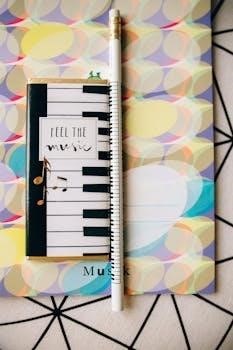Choosing the Right Beginner Piano Book PDF
Selecting the ideal beginner piano PDF involves considering factors like clear notation, engaging exercises, and a logical learning progression․ Look for books with free resources and audio recordings, aiding in effective self-study․
Digital Piano or Keyboard Selection
When starting with a beginner piano book PDF, choosing the right instrument is crucial․ Consider a digital piano or keyboard that has weighted keys to simulate an acoustic piano feel․ This helps develop proper finger strength and technique․ Look for models with a full 88-key range for future growth․ Features like headphone jacks are essential for quiet practice, and built-in metronomes can assist with rhythm development․ A good instrument will enhance your learning experience and make practice more enjoyable․ Remember to explore various options before making a choice․
Piano Learning Methods
Various piano learning methods exist, from traditional instruction to self-guided study using books․ A combination of approaches, including a structured curriculum and practical exercises, often yields the best results․
Overview of Different Approaches
Piano learning approaches vary widely, catering to different learning styles and preferences․ Some beginners thrive with traditional, instructor-led lessons, focusing on theory and technique․ Others prefer self-paced learning using books and online resources, emphasizing practical application․ Apps and interactive software also offer a gamified approach, making learning engaging․ Combining these methods, such as using a book for structure and an app for practice, can provide a well-rounded and effective learning experience, adapting to individual needs and goals․ Choosing the right approach is key to successful piano learning․
Top Piano Learning Apps
Piano learning apps provide interactive lessons, immediate feedback, and progress tracking․ They often incorporate gamified elements, making practice enjoyable and motivating for beginners․
List of 15 Recommended Apps
While the provided text doesn’t explicitly list 15 apps, consider exploring popular options like Flowkey, Simply Piano, and Yousician, which offer structured lessons and feedback․ These applications often feature interactive tutorials, song libraries, and personalized learning paths․ Many incorporate gamified elements to maintain engagement, making learning piano more fun and accessible for beginners․ It’s best to research and find apps tailored to individual learning styles and preferences, often offering free trials for users to test out features․ Look for positive reviews and assess the app’s compatibility with your devices before investing in a subscription․
Piano Basics
Understanding the piano’s layout, the musical alphabet, rhythm, and finger numbers is fundamental․ Beginners should familiarize themselves with notes, octaves, scales, and tones for a solid foundation․
Notes, Octaves, Scales, and Tones
A crucial aspect of piano basics involves understanding musical notes, how they are named, and their placement on the keyboard․ Octaves refer to the interval between notes of the same name․ Mastering scales provides a foundation for playing melodies and harmonies, while recognizing different tones helps in understanding dynamics and expression․ Beginner books often introduce these concepts with simplified exercises and diagrams․ Practicing these elements is crucial for developing a well-rounded understanding of piano playing, setting the stage for more complex musical pieces․

Basic Piano Chords
Learning fundamental chord structures is essential for piano beginners, often starting with simple triads․ Books should provide clear diagrams and finger placement guides for easy understanding and practice․
Beginner piano PDFs typically introduce fundamental chord structures like major and minor triads․ These books often include visual aids, such as diagrams showing finger placements on the keyboard․ Understanding these basic chords is essential for playing simple songs and building a foundation for more complex harmonies․ The material should clearly explain how to construct these chords using the musical alphabet and how they relate to scales․ This will allow beginners to grasp the building blocks of piano music․ A good book will offer exercises to help ingrain these concepts․

Playing Your First Melody
Many beginner piano PDFs feature “Happy Birthday” as a simple starter piece․ This familiar melody allows beginners to practice basic note reading and finger placement, offering a sense of accomplishment․
“Happy Birthday” as a Starter Piece
The inclusion of “Happy Birthday” in many beginner piano PDF books serves as an excellent introduction to playing melodies․ Its simple structure and recognizable tune make it an ideal first piece for new learners․ This allows beginners to focus on basic skills like note identification, rhythm, and finger coordination without getting overwhelmed․ Many of these resources offer free sheet music which supports self-learning; The familiarity of the melody also helps to boost the learner’s confidence and provides a sense of quick achievement, which is very important for new students․

Free Piano Sheet Music for Beginners
Numerous websites offer free beginner piano sheet music in PDF format, allowing learners to access a wide range of resources․ These free materials often include popular melodies and simple exercises․
Resources and Websites for PDFs
Finding free PDF resources for beginner piano is easy with numerous websites dedicated to providing sheet music․ Many sites offer a wide selection of pieces suitable for beginners, often ranging from preparatory levels to grades one and two․ Look for resources that include audio recordings to aid in learning․ These sites are a fantastic way to access both popular songs and essential exercises․ Hal Leonard and other large music publishers also provide beginner materials․ Using these resources, learners can explore a variety of music and enhance their playing skills, often at no cost․

Essential Elements for Beginners
Understanding the keyboard layout, musical alphabet, rhythm values, and finger numbers is crucial for piano beginners․ These basics form the foundation for learning any piece effectively and efficiently․
Keyboard Layout, Musical Alphabet, Rhythm, and Finger Numbers
A beginner piano book PDF should thoroughly explain the keyboard’s white and black key arrangement, emphasizing the patterns and groupings․ It must introduce the musical alphabet (A-G) and how it corresponds to the keys․ Furthermore, understanding rhythm is vital, so it should cover note values like quarter and half notes․ Clear instruction on finger numbering (1-5) is also essential for efficient playing․ These elements provide a solid base for learning piano․ The book should also explain how to sit correctly and how to hold your fingers․
Piano Lesson Planning for Beginners
Effective lesson plans for beginners should incorporate fun, engaging activities, focusing on basic principles of playing the piano․ Regular, frequent practice sessions are necessary for progress․
Structuring Engaging and Effective Lessons
Structuring engaging and effective piano lessons for beginners involves incorporating a variety of activities to maintain interest․ Start with simple exercises focusing on basic notation, rhythm, and finger placement․ Introduce short, fun pieces to practice skills․ Include interactive elements, and use resources like free sheet music PDFs․ Balance technical work with enjoyable playing․ Ensure lessons are frequent and tailored to the student’s individual pace and progress, making learning feel more like a game than a chore․
